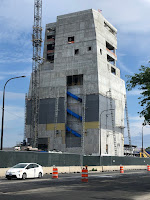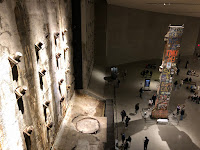Joseph Biden, No. 46
14 December 2024
Wilmington, DE
With a little help from one of Cathy’s co-workers, we were able to do our own version of “The Amazing Race” as we checked out Biden’s Wilmington.
First, we hunted down his house on winding, tree-lined, two-lane Barley Mill Road in the Wilmington suburbs that featured big, stone houses on big, leafy lots.
The Biden house is not visible from the street — Google Maps shows it down the long driveway a bit — nor would you be able to see much of it past the fencing and Secret Service gatehouse anyway. A big, white house stands on the left of the driveway, which we assume is used for either Secret Service agents or guests.
 |
| Driveway of Biden's home |
too kindly to a prolonged stop and we could feel eyes on us from the darkened windows – we hunted down the Jos. A Bank in Greenville where Biden buys his suits, about five minutes from the house.
 |
| Jos A Bank interior |
The men’s retailer is in the middle of the nondescript, brick Greenville Crossing shopping center. We asked one of the associates if Biden really shopped there. He directed us to a senior manager who told us “he (Biden) was just here.” He said that they can tell when a visit is imminent: his “henchmen” suddenly pop in the door to check out the place and clear it. (We didn’t ask how prospective buyers feel about being ejected from the store.) Biden usually comes in with “an entourage.” But sometimes “he comes by himself.” “Does his wife ever come?” we asked. “Sometimes,” he replied. Tom selected some dress shirts to buy, two for $70, one light blue and one dark blue. He asked the young clerk if Biden was popular in the Wilmington area. “Not really,” he replied.
We then diverted to have lunch at McQuinn’s Pub nearby — a tasty French onion soup and salad. Our waitress, 
Enjoying French onion soup
at McQuinn's Pub
like the Jos. A. Bank clerk, said she wasn’t necessarily a big fan of her hometown president and thought he was mentally failing.
Next up was Biden’s church, St. Joseph on the Brandywine Catholic Church, also close to the Biden property. (Is it a coincidence that President Joseph Biden buys his clothes from Joseph A. Banks and attends St. Joseph Church?) Located near the intersection of Kennett Pike and Barley Mill Road, the church complex houses the church, rectory, family center and cemetery. While near a major intersection, it is surrounded by roads and fields, not crowded by other development.

St. Joseph on the Brandywine
Catholic Church
The church is small and simple — with beautiful, long stained-glass windows — and looks very much like a village church you would find in England or Ireland. There is probably a good reason for that — the original church was built in the mid-19th century by Irish workers men who worked for the DuPont gunpowder mills nearby. (The present structure was built in 1947.) A tribute with a Celtic cross is inscribed in the walkway in front of the church. It reads: “In tribute to the Irish workmen who built this church.”
We also explored a bit of the cemetery and found son Beau Biden’s gravesite. He died of brain cancer in 2015. The large upright tomb stone says “Biden” on one side and his name and birth and death dates as well as “Husband, father, brother, son” on the other. There also is another stone marker in the ground that lists his military service.
We didn’t look for the graves of Biden’s first wife and 1-year-old daughter who were killed in a car crash in 1972. (Their two young sons, Beau and Hunter, were injured in that crash.) It turns out that Biden and his family visited the church and cemetery for a private Mass to honor them just three days after our visit.
Then we went to the Wilmington Amtrak station, now known as the Joseph R. Biden Jr. Railroad Station, where
Joseph R. Biden Jr. Railroad Station
“Amtrak Joe” caught the train every day to travel to Washington when he was a senator. We found a plaque and small signage referring to Mr. Biden near the doors to the station. Near the shoe shine chair, there is also a photograph of Biden with one of the attendants. The historic train station, built in 1907 and named for Biden in 2011, is a long, beautiful red brick building with a clock tower.
***
Biden’s first term in the senate began in January 1972 when he was only 29 years old. The accident that took the lives of his wife and daughter had just occurred a month earlier. To keep a family life with his remaining children, Biden would commute to Washington from that Amtrak station every day. He would continue to serve in the Senate until he became Vice President during the Obama administration.
Biden unseated Donald Trump to become president in 2020. The country was in the throes of the Covid pandemic with high death rates and unemployment peaking at a staggering 14.9% – the worst unemployment since the Great Depression. With the passage of the Bipartisan Infrastructure Law and the Inflation Reduction Act, money was injected into the economy allowing a rapid recovery with unemployment eventually falling to about 4%. However, worldwide supply line bottlenecks, pent up demand for goods and services, and large stimulus funding in the U.S. and elsewhere, inflation spiked worldwide. In the United States, annual inflation peaked at 9.1% in June 2022. But by election day in November 2024, it had dropped to 2.7%.
But the damage to the Biden administration was done. His job approval rating was below 40 for most of his presidency. He decided to run for a second term that he would begin at the age of 82. That was four years older than Ronald Reagan was at the end of his presidency. Biden’s abysmal performance during a summer 2024 debate with Donald Trump eventually led him to suspend his campaign. It was later revealed that Biden’s family and staff had hidden the extent of his decline to the public. Biden eventually decided not to run in late July, but that did not leave much time for his chosen successor, Vice President Kamala Harris, to mount a winning campaign.
***

Wilmington
Riverwalk
Before we left Wilmington, we stopped at the Wilmington Riverwalk, a walkway along the Christina River not far from the Amtrak station. We thought there would be a Christmas market at the Riverfront Market building but there were only a few lonely food venders and not many shoppers. We did find a place to buy a hot chocolate and walked in the brisk air along the riverfront. There were not many other walkers out. The fun looking eateries along the walkway were closed but are reportedly packed when the weather is nice. Of interest was Constitution Yards with outdoor seating, volleyball areas and (to Cathy’s delight) containership containers reconfigured as storefronts. But all were closed. There were also three large cranes from the former Dravo Shipyard that were used to build World War II LCMs (landing craft) and offload cargo. In the summer there is a concert series in summer at Dravo Shipyard.
DIRECTIONS
Wilmington, DE is located adjacent to I-95. The closest major airport is Philadelphia International Airport 22 miles north.
REFERENCES
New York Times. 2025. How Biden’s Inner Circle Protected a Faltering President. 17 January 2025.
Websites
wikipedia
https://www.whitehousehistory.org/bios/joseph-r-biden-jr
Whitehouse.gov













